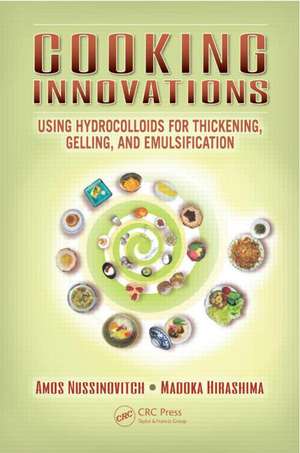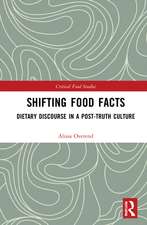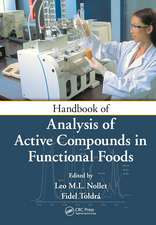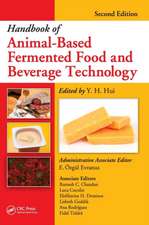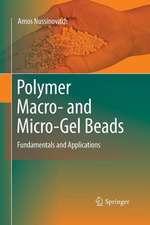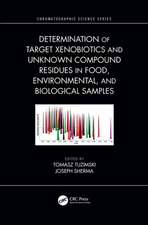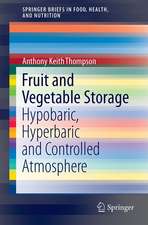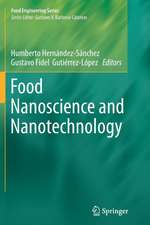Cooking Innovations: Using Hydrocolloids for Thickening, Gelling, and Emulsification
Autor Amos Nussinovitch, Madoka Hirashimaen Limba Engleză Hardback – 9 oct 2013
Each chapter addresses a particular hydrocolloid, protein hydrocolloid, or protein–polysaccharide complex. Starting with a brief description of the chemical and physical nature of the hydrocolloid, its manufacture, and its biological/toxicological properties, the emphasis is on practical information for both the professional chef and amateur cook. Each chapter includes recipes demonstrating the particular hydrocolloid’s unique abilities in cooking. Several formulations were chosen specifically for food technologists, who will be able to manipulate them for large-scale use or as a starting point for novel industrial formulations.
The book covers the most commonly used hydrocolloids, namely, agar–agar, alginates, carrageenan and furcellaran, cellulose derivatives, curdlan, egg proteins, galactomannans, gelatin, gellan gum, gum arabic, konjac mannan, pectin, starch, and xanthan gum. It also discusses combining multiple hydrocolloids to obtain novel characteristics. This volume serves to inspire cooking students and introduce food technologists to the many uses of hydrocolloids. It is written so that chefs, food engineers, food science students, and other professionals will be able to cull ideas from the recipes and gain an understanding of the capabilities of each hydrocolloid.
Preț: 575.04 lei
Preț vechi: 804.69 lei
-29% Nou
Puncte Express: 863
Preț estimativ în valută:
110.05€ • 119.49$ • 92.44£
110.05€ • 119.49$ • 92.44£
Carte tipărită la comandă
Livrare economică 22 aprilie-06 mai
Preluare comenzi: 021 569.72.76
Specificații
ISBN-13: 9781439875889
ISBN-10: 143987588X
Pagini: 380
Ilustrații: 119 colour illustrations
Dimensiuni: 156 x 234 x 23 mm
Greutate: 0.77 kg
Ediția:1
Editura: CRC Press
Colecția CRC Press
ISBN-10: 143987588X
Pagini: 380
Ilustrații: 119 colour illustrations
Dimensiuni: 156 x 234 x 23 mm
Greutate: 0.77 kg
Ediția:1
Editura: CRC Press
Colecția CRC Press
Public țintă
Food scientists, food technologists, food engineers, research chefs, professional chefs, amateur cooks, students of cooking science and food processing, and cooking enthusiasts.Cuprins
Hydrocolloids—Where, Why, and When? Agar–Agar. Alginates. Carrageenan and Furcellaran. Cellulose Derivatives. Curdlan. Egg Proteins. Galactomannans. Gelatin. Gellan Gum. Gum Arabic. Konjac Mannan. Pectin. Starch. Xanthan Gum. The Use of Multiple Hydrocolloids in Recipes. Glossary. Alphabetical List of Hydrocolloid Manufacturers and Suppliers. Index.
Notă biografică
Professor Amos Nussinovitch was born in Kibbutz Megiddo, Israel. He studied chemistry at the University of Tel Aviv, and food engineering and biotechnology at the Technion – Israel Institute of Technology. He has worked as a food engineer at several companies and has been involved in a number of R&D projects in both the United States and Israel, focusing on the mechanical properties of liquids, semisolids, solids, and powders.
He is currently in the Biochemistry and Food Science Department of the Robert H. Smith Faculty of Agriculture, Food and Environment of the Hebrew University of Jerusalem, Israel, where he leads a large group of researchers working on theoretical and practical aspects of hydrocolloids. Prof. Nussinovitch is the sole author of five books, the author or coauthor of numerous papers on hydrocolloids and on the physical properties of foods, and an inventor on many related patent applications.
Madoka Hirashima, Ph.D., was born in Kyoto, Japan. She studied the rheological properties of curdlan and cornstarch at the Graduate School of Human Life Science, Osaka City University. Dr. Hirashima worked at a food company as a new food developer, and then as a lecturer at several colleges. She is currently in Home Economics Education at the Faculty of Education, Mie University, where she teaches cooking as well as cooking science. She continues to study the rheological properties of polysaccharides, with a focus on the textures of starch and konjac products.
He is currently in the Biochemistry and Food Science Department of the Robert H. Smith Faculty of Agriculture, Food and Environment of the Hebrew University of Jerusalem, Israel, where he leads a large group of researchers working on theoretical and practical aspects of hydrocolloids. Prof. Nussinovitch is the sole author of five books, the author or coauthor of numerous papers on hydrocolloids and on the physical properties of foods, and an inventor on many related patent applications.
Madoka Hirashima, Ph.D., was born in Kyoto, Japan. She studied the rheological properties of curdlan and cornstarch at the Graduate School of Human Life Science, Osaka City University. Dr. Hirashima worked at a food company as a new food developer, and then as a lecturer at several colleges. She is currently in Home Economics Education at the Faculty of Education, Mie University, where she teaches cooking as well as cooking science. She continues to study the rheological properties of polysaccharides, with a focus on the textures of starch and konjac products.
Descriere
This volume explores unique applications of hydrocolloids in the kitchen. Starting with a brief description of the chemical and physical nature of the hydrocolloid, its manufacture, and its biological/toxicological properties, the emphasis is on practical information for both the professional chef and amateur cook. Each chapter includes recipes demonstrating the particular hydrocolloid’s unique abilities in cooking. Several formulations were chosen specifically for food technologists, who will be able to manipulate them for large-scale use or as a starting point for novel industrial formulations.
